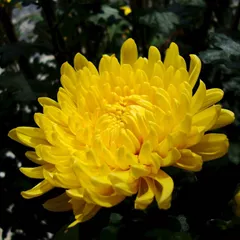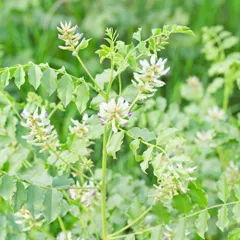Sang Ju Yin
Chinese: 桑菊饮
Pinyin: Sāng Jú Yǐn
Other names: Mulberry Leaf and Chrysanthemum Drink, Morus and Chrysanthemum Combination








Sang Ju Yin
Chinese: 桑菊饮
Pinyin: Sāng Jú Yǐn
Other names: Mulberry Leaf and Chrysanthemum Drink, Morus and Chrysanthemum Combination
Ingredients: 8 herbs
Category: Formulas that clear Wind-Heat
- Disperses Wind
- Stops coughing by invigorating Lung Qi
- Clears Heat
Source: Systematic Differentiation of Warm Pathogen Diseases (1798 AD)
The information provided here is not a replacement for a doctor. You shouldn't use it for the purpose of self-diagnosing or self-medicating but rather so you can have a more informed discussion with a professional TCM practitioner.
Sang Ju Yin is a 8-ingredient Chinese Medicine formula with Mulberry Leaves (Sang Ye) and Chrysanthemum Flowers (Ju Hua) as principal ingredients.
Invented in 1798 AD, it belongs to the category of formulas that clear Wind-Heat. Its main actions are: 1) disperses Wind and 2) stops coughing by invigorating Lung Qi.
In Chinese Medicine health conditions are thought to arise due to "disharmonies" in the body as a system. These disharmonies are called "patterns" and the very purpose of herbal formulas is to fight them in order to restore the body's harmony.
In this case Sang Ju Yin is used by TCM practitioners to fight patterns like Wind-Heat or Toxic-Heat. From a Western Medicine standpoint, such patterns can give rise to a range of conditions such as common cold, influenza or bronchitis for instance.
On this page, after a detailed description of each of the eight ingredients in Sang Ju Yin, we review the patterns and conditions that Sang Ju Yin helps treat.
The eight ingredients in Sang Ju Yin

Sang Ye is a king ingredient in Sang Ju Yin. Like the name indicates, it means it has more power than other ingredients in the formula.
1. Mulberry Leaves (Sang Ye)
Part used: Dried leaves
Nature: Cold
Sang Ye is cool and light. Its flavor is bitter and sweet. It can clear Heat from the Exterior. It helps stop coughing by removing the Lung Heat.

Ju Hua is a king ingredient in Sang Ju Yin. Like the name indicates, it means it has more power than other ingredients in the formula.
2. Chrysanthemum Flowers (Ju Hua)
Part used: Dried capitulum
Nature: Cool
In general Ju Hua's main actions are as follows: "Relieves the Exterior and clears Heat. Relieves Wind-Heat from the Liver channel and clears the eyes. Cools Heat of the Liver and Kidney due to Yin Deficiency. Relieves patterns of Liver Yang rising."
In the context of Sang Ju Yin, it is used because it disperses Wind Heat in the Upper Burner, including the eyes affecting one.

Lian Qiao is a deputy ingredient in Sang Ju Yin. This means it helps the king ingredient(s) treat the main pattern or it serves to treat a coexisting pattern.
3. Forsythia Fruits (Lian Qiao)
In general Lian Qiao's main actions are as follows: "Expels Heat and toxicity from the Blood. Dispels External Wind-Heat. Reduces lumps, swollen lymph nodes and sores of a Heated nature."
In the context of Sang Ju Yin, it is used because it assists the formula in releasing the Exterior.

Bo He is a deputy ingredient in Sang Ju Yin. This means it helps the king ingredient(s) treat the main pattern or it serves to treat a coexisting pattern.
4. Wild Mint (Bo He)
In general Bo He's main actions are as follows: "Relieves the Exterior and disperses Wind-Heat. Clears Wind-Heat from the head, eyes and throat. Allows the release of toxins from the skin. Moves Stagnant Liver Qi"
In the context of Sang Ju Yin, it is used because it assists the formula in releasing the Exterior.

Jie Geng is a deputy ingredient in Sang Ju Yin. This means it helps the king ingredient(s) treat the main pattern or it serves to treat a coexisting pattern.
5. Platycodon Roots (Jie Geng)
Jie Geng helps the two key herbs in invigorating the Lung Qi and stopping coughing by directing the Qi upwards.

Xing Ren is a deputy ingredient in Sang Ju Yin. This means it helps the king ingredient(s) treat the main pattern or it serves to treat a coexisting pattern.
6. Apricot Seeds (Xing Ren)
Part used: Dried ripe seeds
Nature: Warm
Meridian affinity: Large intestineLung
Category: Herbs that relieve coughing and wheezing
Xing Ren helps the two key herbs in invigorating the Lung Qi and stopping coughing by directing the Qi downwards.

Lu Gen is an assistant ingredient in Sang Ju Yin. This means that it either serves to reinforces the effect of other ingredients or it moderates their toxicity.
7. Common Reed Rhizomes (Lu Gen)
Part used: Fresh or dried rhizome
Nature: Cold
Taste(s): Sweet
Meridian affinity: LungStomach
Category: Herbs that clear Heat and purge Fire and/or clear Summer Heat
In general Lu Gen's main actions are as follows: "Clears Heat and promotes the generation of Fluids. Dispels Lung Heat. Dispels Stomach Heat. Promotes urination and clears Heat in the urinary tract. Calm the minds and stop vomiting."
In the context of Sang Ju Yin, it is used because it clears Heat and generates Body Fluids so as to reduce thirst.

Gan Cao is an envoy ingredient in Sang Ju Yin. This means that it directs the formula towards certain area of the body and/or harmonizes the actions of other ingredients.
8. Liquorice (Gan Cao)
Part used: Dried root and rhizome
Nature: Neutral
Taste(s): Sweet
Meridian affinity: HeartLungSpleenStomach
Category: Tonic herbs for Qi Deficiency
In general Gan Cao's main actions are as follows: "Tonifies the Basal Qi and nourishes the Spleen Qi. Clears Heat and dispels toxicity. Moistens the Lungsexpel phlegm and stop coughing. Relieves spasms and alleviates pain. Harmonizes and moderates the effects of other herbs."
In the context of Sang Ju Yin, it is used because it helps clear the Heat and harmonizes the actions of the other herbs.
Conditions and patterns for which Sang Ju Yin may be prescribed
It's important to remember that herbal formulas are meant to treat patterns, not "diseases" as understood in Western Medicine. According to Chinese Medicine patterns, which are disruptions to the body as a system, are the underlying root cause for diseases and conditions.
As such Sang Ju Yin is used by TCM practitioners to treat two different patterns which we describe below.
But before we delve into these patterns here is an overview of the Western conditions they're commonly associated with:
Common cold Influenza Bronchitis Pneumonia Tonsillitis Conjunctivitis
Again it wouldn't be correct to say "Sang Ju Yin treats common cold" for instance. Rather, Sang Ju Yin is used to treat patterns that are sometimes the root cause behind common cold.
Now let's look at the two patterns commonly treated with Sang Ju Yin.

'Heat' as a body pattern in Chinese Medicine is one of the so-called "Eight Principles". Learn more about Heat pattern in Chinese Medicine
Wind-Heat
Pulse type(s): Rapid (Shu), Floating (Fu)
Symptoms: Fever Chills Thirst Sneezing Coughing Sweating Headaches Runny nose Sore throat Yellow mucus Fear of wind Blocked nose Itchy throat Swollen tonsils Aversion to cold Occipital stiffness Occipital headaches
Sang Ju Yin is sometimes prescribed by TCM practitioners to treat Wind-Heat. This pattern leads to symptoms such as aversion to cold, fever, sneezing and coughing. Patients with Wind-Heat typically exhibit rapid (Shu) or floating (Fu) pulses.
Within the Four-Levels theory, Wind-Heat is the first level of invasion of External Pathogens, when it still resides in the body's Exterior.
This pattern is similar to Wind-Cold, but the Wind is together with Heat rather than Cold. The common symptoms are aversion to cold, sneezing, coughing, runny... read more about Wind-Heat

'Heat' as a body pattern in Chinese Medicine is one of the so-called "Eight Principles". Learn more about Heat pattern in Chinese Medicine
Toxic-Heat
Pulse type(s): Rapid (Shu)
Tongue coating: Yellow coating
Tongue color: Red
Symptoms: Pus Fever Boils Sores Eczema Thirst Pustule Coughing Erythema Swellings Carbuncles Dark Urine Sore throat Mouth ulcers Constipation Abdominal pain Swollen tonsils Feeling of heat Lower back pain Perineum swollen Prostate swollen Testicle swollen Red skin eruptions Shortness of breath Yellow vaginal discharge Smelly Vaginal discharge Sticky vaginal discharge Bloody vaginal discharge Five colour vaginal discharge
Sang Ju Yin is sometimes prescribed by TCM practitioners to treat Toxic-Heat. This pattern leads to symptoms such as fever, swellings, pus and boils. Patients with Toxic-Heat typically exhibit rapid (Shu) pulses as well as Red tongue with yellow coating.
There are two types of Toxic-Heat. One type is called Toxic-Heat Stagnation, which mainly happens in Channels or other surfaces like skins, throat, lymph or mouth. The symptoms include pain, redness and swollen in throat as well as skin pustule and rush. Acne during teenage time is mainly due to... read more about Toxic-Heat
Formulas similar to Sang Ju Yin
Yin Qiao San is 50% similar to Sang Ju Yin
Yin Qiao Jie Du Wan is 44% similar to Sang Ju Yin
Jia Jian Wei Rui Tang is 38% similar to Sang Ju Yin
Liang Ge San is 38% similar to Sang Ju Yin
Qing Zao Jiu Fei Tang is 33% similar to Sang Ju Yin
Qing Xin Li Ge Tang is 31% similar to Sang Ju Yin













